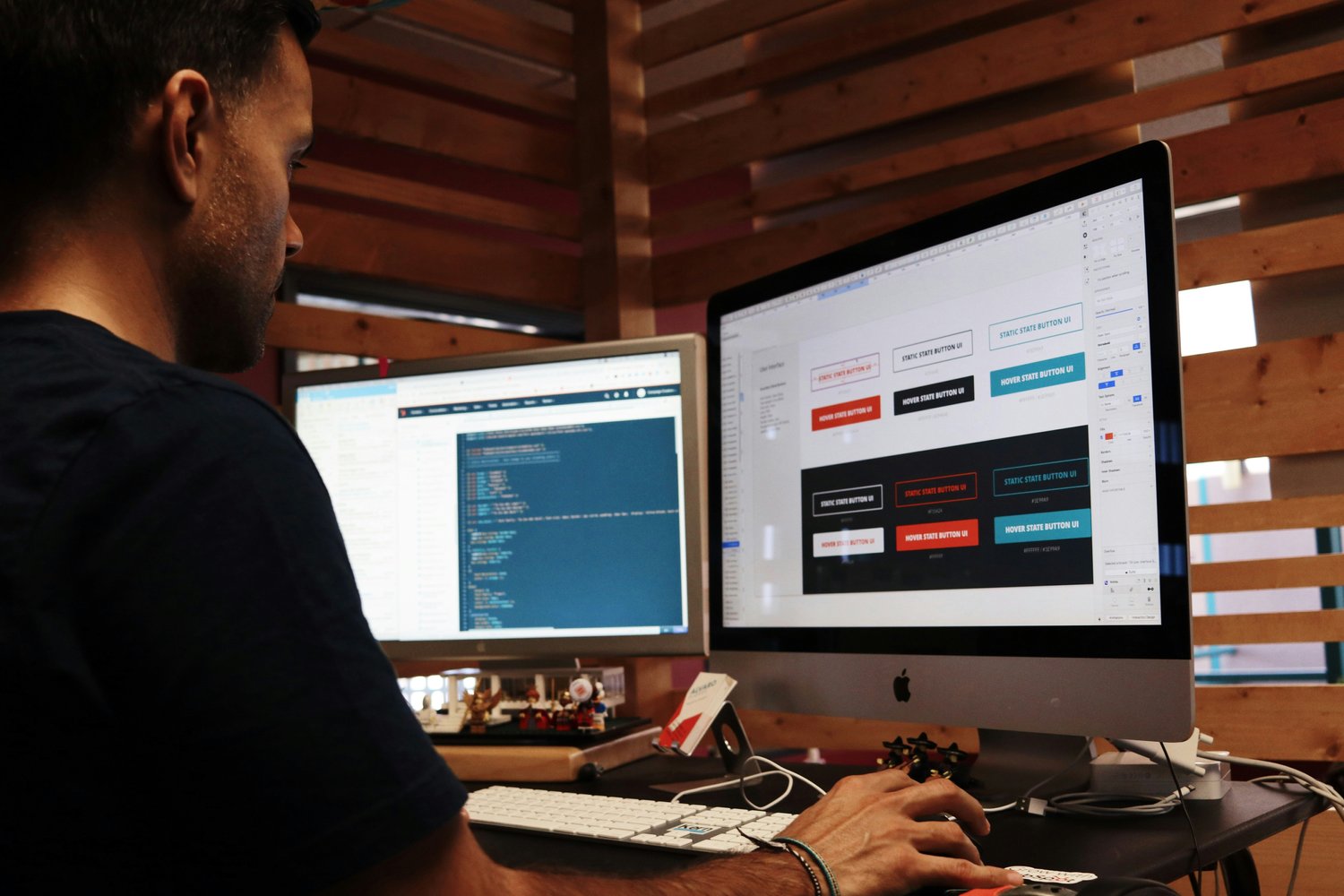Image: https://unsplash.com/photos/man-using-apple-computer-iEiUITs149M
Web design greatly affects conversion rates in San Antonio. A well-designed website with a web design company in San Antonio, TX improves user experience by guiding visitors and encouraging action. Key factors like page load speed, mobile responsiveness, and clear calls-to-action influence user engagement and conversions. In San Antonio’s competitive market, optimizing web design can enhance engagement and increase conversions for businesses of all sizes.
What Is Conversion Rate?
Web design is critical in conversion rate enhancement in San Antonio. An intuitive layout with distinct designs, interesting images, and minimal menus keeps visitors interacting. Powerful calls-to-action make customers out of users. A cluttered design is not helpful because it irritates visitors and leads to high bounce rates, thus threatening a business’s success in its online endeavor.
Understanding Conversion Rate
It represents how well the website is convincing visitors to perform actions such as subscribing or buying. For instance, if 1,000 visitors make 50 purchases, the conversion rate is 5%. Tracking the rate will also help to spot problems in user engagement, for example, confusion with the navigation or poorly designed calls to action. Average conversion rates range around 2.35% while the best performers exceed 11.45%.
Why Conversion Rate Matters for Businesses
A high conversion rate will directly result in increased revenue and growth, showing that visitors are interested. Customers are scared off by complicated checkout processes and confusing layouts. Conversion rates allow marketers to optimize their strategies and website design to reach their target audiences, make better use of their resources, and maximize campaign ROI and online visibility.
Factors Affecting Conversion Rates
Website design is the core of conversion rates. An organized, mobile-friendly website provides a better user experience and instills trust, and other elements such as testimonials and security badges increase credibility. Market trends and competition also impact user behavior. Businesses should concentrate on meaningful changes to boost conversion rates and improve user experience.
How Web Design Affects Conversion Rates
User behavior and conversion rates are influenced a lot by web design. Businesses in San Antonio that are interested in boosting online performance need to focus on features that improve user engagement and prompt desired actions. A good website is user-experience-driven, making it easy for visitors to find what they need and accomplish tasks.
1. Role of Visual Appeal in Conversions
Visual appeal significantly influences how users view and use a website. Attractive elements, like warm colors, highlight key features such as call-to-action (CTA) buttons. Quality images and clear fonts improve readability and the site’s look. A pleasing design fosters trust and encourages users to explore. Consistent branding—logos, fonts, and colors—enhances trust and recognition over time.
2. Impact of Navigation on User Decisions
Navigation is essential for guiding users on a website. Simple layouts reduce bounce rates and encourage exploration. Clear categories and dropdown menus help users locate actions like the “Contact” form or checkout page easily. Breadcrumbs enable easy backtracking, and search bars enhance user experience by offering quick access to content.
3. Importance of Mobile-Friendly Design
Over half of consumers use mobile devices, making a mobile-friendly website essential. Sites optimized for smaller screens improve browsing and shopping experiences. Research indicates that well-designed mobile sites boost conversions by removing obstacles. Poor formatting and slow loading can drive users away. Without a solid mobile presence, businesses risk losing nearly 90% of their traffic to competitors.
4. Influence of Loading Speed on Engagement
Fast loading times are vital for keeping visitors engaged. Users expect pages to load in 2 seconds or less, as delays can result in lost sales and trust. Tools like Google PageSpeed Insights and techniques such as image compression and caching can enhance speed. A faster website captures user attention, reduces bounce rates, and increases conversions.
5. Effects of Content Layout on Readability
A well-structured design lets users understand the message and stay on it. Headings, subheadings, and even bullet points will make your text easily scannable. Images and infographics give it visual strength, but the content has to be concise with all necessary details. For example, a clear “Product” header with an “Order Now” button directs users to what to do next.
6. Connection Between Trust and User Experience
Trust is crucial for online conversions. A professional design increases credibility, and clear return policies and contact details make users feel secure. Design influences about 75% of a site’s credibility. By prioritizing strong aesthetics and functionality, you can greatly improve customer confidence and engagement.
Strategies to Improve Web Design for Conversions
To boost web design for conversions, establish a clear layout that guides users toward action. Use bold, action-oriented CTAs in contrasting colors and position them strategically to promote engagement. Optimizing for mobile devices improves the experience for all visitors, fostering a positive journey that drives conversions.
Conducting User Behavior Analysis
Knowing how visitors interact with a website helps to improve its performance. Metrics such as click-through rates, time on pages, and bounce rates provide important insights into user experience. For instance, if the bounce rate is high, it might be due to navigation or content problems. Tools like Google Analytics and Hotjar can be applied to map out user behavior and help in locating the problems. With these metrics, you can work on your web design to better fit user needs and increase conversions.
Implementing A/B Testing for Optimization
A/B testing allows companies to understand how small changes in design can impact user behavior. Common tests would involve changing the button color, headlines, and layouts. From looking at the results, a company can know which design will increase metrics such as click-through rates or sign-ups. It increases confidence in design decisions and assures that updates will indeed improve conversions and other goals.
Prioritizing Responsive and Mobile Design
Google recommends responsive design for sites to make sure they work well on desktops, tablets, and smartphones. A mobile-first approach prioritizes the most important features on smaller screens, improving user experience and search rankings since Google has a preference for mobile-friendly sites. Consistent experiences across devices keep users engaged and ultimately drive up conversion rates.
Enhancing Page Speed and Performance
Fast-loading websites keep visitors engaged and reduce bounce rates. To boost speed, compress images, enable browser caching, and eliminate unnecessary code. Even a one-second delay can drive visitors away. A site that performs well ensures quick loading and smooth navigation, significantly improving conversion rates by maintaining user interest.
Continuous Updates Based on Feedback
Regularly updating a website with user feedback and industry trends keeps it relevant. Ongoing optimizations, such as A/B testing and adding visuals, enhance its appeal. Insights from surveys and heatmaps inform updates, ensuring the site meets user needs. This continuous process improves usability and increases conversions over time.
How Effective Web Design Drives Conversion Rates in San Antonio
Web design is crucial for how visitors engage with a site and make choices. A clear, user-friendly design fosters trust and connection with the San Antonio community. Simple updates like better navigation and mobile-friendly layouts can greatly improve conversion rates. While bad design drives visitors away, good design keeps them interested. For San Antonio businesses, effective web design enhances user experience, strengthens local ties, and increases conversions, all vital for growth. Fixing design issues now can yield lasting benefits and help convert visitors into customers.
Texas Web Design
9993 Frontage Rd Suite 101, San Antonio, TX 78230
+12109858528



